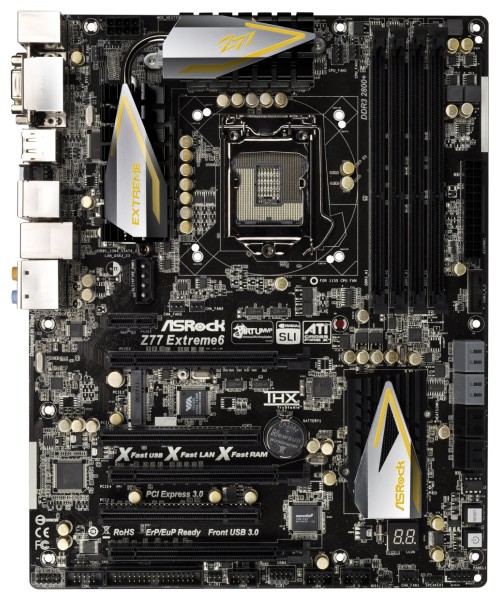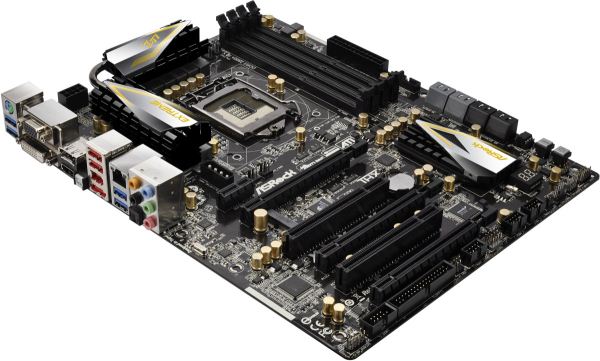Intel Z77 Panther Point Chipset and Motherboard Preview – ASRock, ASUS, Gigabyte, MSI, ECS and Biostar
by Ian Cutress on April 8, 2012 12:00 AM EST- Posted in
- Motherboards
- Intel
- Biostar
- MSI
- Gigabyte
- ASRock
- Asus
- Ivy Bridge
- ECS
- Z77
ASRock Z77 Extreme6—Visual Inspection
With the Extreme6, compared to the Extreme4, there are a significant number of changes, both visual and in terms of features. For a start, the heatsink design is more pronounced, using something similar to their X79 range in terms of black and gold ridged and edged surfaces. The VRM heatsink design is more substantial than the Extreme4, even though online it states it is still only an 8 + 4 VRM design—actually looking at the board, it seems more of a 10 + 4 design.
By looking at the motherboard, you would assume that it would support three-GPU setups. Unfortunately, this third full-length PCIe lane is only PCIe 2.0 x4, rather than splitting up the PCIe 3.0 lanes x8/x4/x4 or using a PLX chip. The MSRP for this board should be around $177, indicating that perhaps that is too cheap a board for one of the expensive PCIe 3.0 expansion PLX chips.

Onboard is also an mSATA port, right in the middle between the first PCIe slot and the PCI slot. Above the PCIe slots is a 4-pin molex power connector to provide extra power to the PCIe slots, although I am kind of getting tired of seeing it put in this location. If anything, it should be at the bottom end or beside the 24-pin power connector, as having it above the PCIe slots just means that there will be cables all over the place.
One other less obvious change to the Extreme4 is that there is a Floppy drive header on board. Yes, you heard me right—floppy drive! It seems odd now to include this legacy connection. It still has a place in industrial concepts (where a machine uses floppy drives and costs 1000x more than the PC processing its data), but not particularly on a higher end product which may be geared towards gaming and overclocking. Perhaps if ASRock are the only ones, then it creates a niche just for them.
In terms of fan headers on board, we have one three-pin beside the 8-pin 12V power connector, two CPU headers (one 4-pin, one 3-pin) just to the right of the top heatsink, two chassis three-pin headers beside the molex connector, and another 4-pin chassis header on the bottom of the board. On the right hand side, the USB 3.0 connector has been placed beneath the 24-pin ATX power connector, followed by the SATA ports. Like the Extreme4, we have the PCH SATA ports (two SATA 6 Gbps and four SATA 3 Gbps) and two extra SATA 6 Gbps from an ASMedia ASM1061 controller.
Around the larger chipset heatsink, we have power/reset buttons and a two digit debug display, both of which I personally like to see as a reviewer (makes my job a bit easier) but also helps overclockers. On the south side of the board, apart from that floppy connector I mentioned, we have a COM port, front panel audio, and an array of USB 2.0 headers.
PCIe layout is similar to the Extreme6, with a PCIe x1, PCIe 3.0 x16/x8, an mSATA connector, PCI, PCIe 3.0 x8, PCI, and a PCI 2.0 x4. This allows a user to use a dual GPU setup, and still have access to a PCIe x1 and x4.

Aside from the bowed picture from ASRock, we have something similar to the Extreme4 for the IO back panel, though this time with a DisplayPort output. From left to right, we have a combination PS/2 port, two USB 3.0 ports (blue), a D-Sub port, DVI-D, DisplayPort, HDMI, a ClearCMOS button, two USB 2.0 (red), an IEEE1394 port, eSATA, gigabit Ethernet, two more USB 3.0 (blue), and audio outputs including an optical SPDIF.
Board Features
| ASRock Z77 Extreme6 | |
| Size | ATX |
| CPU Interface | LGA-1155 |
| Chipset | Intel Z77 |
| Power Delivery | 8 + 4 |
| Memory Slots |
Four DDR3 DIMM slots supporting up to 32 GB Up to Dual Channel, 1066-2800 MHz |
| Video Outputs | DisplayPort, HDMI 1.4a, DVI-D, D-Sub |
| Onboard LAN | Broadcom BCM57781 |
| Onboard Audio | Realtek ALC898 |
| Expansion Slots |
2 x PCIe x16 Gen3 (x16, x8/8) 1 x PCIe x16 Gen2 (x4) 1 x PCIe x1 Gen2 2 x PCI 1 x mini PCIe |
| Onboard SATA/RAID |
2 x SATA 6 Gbps (PCH), Support for RAID 0, 1, 5, 10 2 x SATA 6 Gbps (ASMedia ASM1061) 4 x SATA 3 Gbps (PCH), Support for RAID 0, 1, 5, 10 |
| USB |
Two USB 3.0 at rear (PCH) Two USB 3.0 at rear (Etron EJ168A) One USB 3.0 header (PCH) |
| Onboard |
4 x SATA 6 Gbps 4 x SATA 3 Gbps 1 x Floppy Connector 1 x IR Header 1 x CIR Header 1 x COM Header 1 x SPDIF Header 1 x 4-pin Molex power connector Power/Reset Buttons Two Digit Debug LED 6 x Fan Headers Front panel audio connector 3 x USB 2.0 headers (support 6 USB 2.0 ports) 1 x USB 3.0 header (supports 2 USB 3.0 ports) |
| Power Connectors |
1 x 24-pin ATX connector 1 x 8-pin 12V connector 1 x 4-pin Molex for PCIe |
| Fan Headers |
2 x CPU Fan Header (one 4-pin, one 3-pin) 3 x CHA Fan Headers (one 4-pin, two 3-pin) 1 x SYS Fan Header (one 3-pin) |
| IO Panel |
1 x Combo PS/2 Port 1 x DisplayPort 1 x HDMI 1.4a 1 x DVI-D 1 x D-Sub 1 x Optical SPDIF 2 x USB 2.0 4 x USB 3.0 1 x IEEE1394 1 x Gigabit Ethernet 1 x Clear CMOS Audio Outputs |
| Warranty Period | 3 years from date of purchase |
| Product Page | Link |
Nothing immediately jumps out from the board features list aside from the differences to the Extreme4. This is a quite good package for an MSRP of $171.











145 Comments
View All Comments
MrSpadge - Sunday, April 8, 2012 - link
"multiples of 15 Hz (15, 30, 35, 60, 75)" on page 2Ryan Smith - Sunday, April 8, 2012 - link
Got it. Thanks.MrSpadge - Sunday, April 8, 2012 - link
How does it work together with nVidias adaptive VSync, which debuted with the GTX680? And which, IMO, looked quite promising (lowering average power consumption a lot while gaming).Ryan Smith - Sunday, April 8, 2012 - link
You wouldn't use MVP with Adaptive V-Sync. It only makes sense to use MVP by itself.Thaine - Thursday, August 16, 2012 - link
"Predicting which frames (or rendering tasks) will never be shown and taking them out of the pipeline so the GPU can work on what is needed"Along the lines of power consumption (and the ever-important side effect, heat), I would be very interested in seeing an article on MVP vs power consumption/heat on a power-hungry dGPU (ala GTX 480).
primonatron - Sunday, April 8, 2012 - link
Not sure why most of these boards bother including the non-Intel USB 3.0 controllers any more.Not many people have several USB 3.0 devices, so they could be saving costs. Or instead bringing back some of the things the article mention were taken away - like DVI on an ASUS board.
GreenEnergy - Sunday, April 8, 2012 - link
I think board makers are getting desperate for ways to add value.Less and less components to change and diversify with.
And its not getting better in the future. Haswell on LGA1150 basicly removes the entire VRM part on the motherboard. No more 32 phases or whatever.
A 50$ board performs identical to a 200$ board if you dont overclock. Actually the 50$ board might be more reliable (less components to fail) and more power efficient.
Xale - Sunday, April 8, 2012 - link
50 dollar boards are probably going to at least boot faster. The driver load and POST times with many 3rd party controllers, SATA especially, is atrocious. Seen some boards that take nearly 3x longer if the external controllers aren't disabled.Metaluna - Sunday, April 8, 2012 - link
Mostly marketing I would guess. Intel only supports 4 3.0 ports, so if you add another chip you now have a checklist item to justify the premium price of your motherboard and possibly differentiate it from lower-end versions in the same product line.Second, ASUS owns ASMedia, who makes a lot of the (mediocre, IMHO) USB 3 and Bluetooth controllers on their boards, so there's probably an incentive to use them in their own products to help prop up their production volumes.
Third, a lot of the third party controllers have special modes to support things like high-current charging for iPads or charging when the computer is turned off. Does anyone know if it's possible to add these features to Intel-based ports? If not, that would be an incentive to include a secondary chip.
GreenEnergy - Sunday, April 8, 2012 - link
I saw the DH77DF im looking at myself got high current recharge. So that doesnt seem to be related to the controller at all.